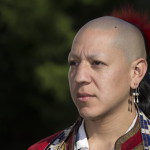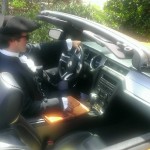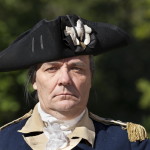A little while back we had some fun asking what types of cars 18th-century Virginians might drive today. After all, many people consider their vehicles extensions of their personality, or at least reflections of them. Well, we decided it was time to survey a new group of our talented historical interpreters for more answers to this question.
Here, mostly in their own words, are the answers to our query. I think you’ll agree they offer insight into who these people were and how we can relate to them today. We begin with the Father of Our Country. . .
George Washington
“Washington would drive something useful and symbolic. It would be American because of his interest in supporting domestic economy. Because he is a farmer it would be a truck, most likely a Chevy or a Ford. I believe Washington would choose the Ford, mostly due to the symbolic ties that the brand has created through history. In my opinion he would drive a Ford F350 pickup, probably converted to biofuel so his farms could provide the fuel. It would, of course, be white. His love for speed might cause him to have a secondary more sporty car as well, but the truck would be what he drove when home.”
—Ron Carnegie
Robert Mush
Robert Mush (sometimes spelled Mursh or Marsh) came from the Pamunkey Indian town in King William County to Williamsburg in 1769, where he attended the Brafferton, the College of William & Mary’s Indian school. He joined the 15th Virginia Regiment during the Revolution, fought at Brandywine and Yorktown, and was even held on a prison barge in Charleston for 14 months.
“I would say that Robert Mush would most likely drive a 2015 Dodge Hellcat. The car would be more of a statement, and that statement would be, “Hey, I like to travel in style but I also like to go too fast too quick-welcome to my wild side.”
—Warren Taylor
Lydia Broadnax
Lydia Broadnax was an enslaved woman in George Wythe’s household who stayed on his cook after gaining her freedom in 1787, when she was about 45 years old.
“I do not think Lydia would have had her own car until she was granted her freedom. She was enslaved for approximately the first 47 years of her life, but her story shifts in 1787 when she was manumitted. I imagine what she must have felt – unfettered and self-possessed for the first time in her life. I remember when I got my first car and the freedom that I felt. I could go anywhere I wanted. Suddenly my life opened up! There were more possibilities of what I could do and be. I love to think of Lydia driving down a picturesque road on a beautiful day, windows open, feeling the rush of autonomy, the wind blowing her cap off – free!
“Lydia is sassy, no-nonsense, efficient, pragmatic, hard-working, smart and fun-loving. She would drive something stylish and efficient, but not too fussy. She’s all about getting things done, but she doesn’t need to be flashy about it. She would drive a slate gray hybrid-electric Ford Fusion.”
—Katrinah Lewis
James Madison
“Madison was thought to be surprisingly cosmopolitan considering he never left American soil, trying to keep up to date with all the latest fashions from Europe. He almost always dressed in black, preferring the image of stateliness and frugality it presented. Despite living in cities a good portion of his life, he loved the agrarian life and once remarked that man could not make nature ‘subordinate to his desires’ but instead needed to find the ‘symmetry in nature.’
“For that reason, the vehicle that most comes to mind for me is… the Audi Q5 Hybrid. It has all the civility of a luxury car with the extra bit of frugality on gas mileage and emissions and can handle the long and winding wood to get to the tranquil air of Montpelier with storage enough to haul whatever farm equipment (or wardrobe selection for Dolley). And of course, it would be black.”
—Bryan Austin
Alexander Purdie
Mr. Purdie was the editor of one of three competing publications of the Virginia Gazette. It is believed that he hailed from Scotland and learned the printing business before immigrating to Virginia.
“Purdie would drive a 2016 Land Rover 4-wheel drive customized to reflect his success, its durability ( British goods being ever the best!)* would allow Purdie to get about anywhere to gather news etc., and travel the countryside, and color would be blue, my wife Peachy said it should be the color of my eyes that she loves so much.”
—Dennis Watson
*For the uninitiated, this is a shout-out to a favorite line from Williamsburg: The Story of a Patriot
Hannah Powell
Hannah Powell was born in 1753, so she was a young woman as the American Revolution broke out. The Powells were a family on the rise in 18th-century Williamsburg. Her father Benjamin was a carpenter and joiner who also held public office. Her mother oversaw a busy household with children and enslaved African Americans. Hannah married William Drew in 1776.
“Given what I know about Hannah, I think she would have wanted to drive a 1968 AC Shelby Cobra 427. Hannah would not have owned her own car. Financially and legally, Hannah was not allowed to participate as a separate entity from her husband, William Drew, in the 18th century. It would have been his credit that purchased the car, much like the actual phaeton that showed up in their 1785 inventory.
“The Shelby Cobra has a chassis build in the U.K. but a drive train made in the U.S.—the perfect blend for a former British subject and a current American citizen. As an open-top roadster, the Shelby Cobra is a car where you are meant to be seen. Like the phaeton the Powells owned, it wasn’t the most practical vehicle, but it certainly made a distinct statement: that of power, class, wealth, and opportunity. Most of the ’68s came with a manual transmission, which is perfect for Hannah. Its manual transmissions were more reliable than automatic in inclement weather.”
—Nicole Brown
Richard Charlton
When Richard Charlton was the proprietor of Williamsburg’s coffeehouse in the 1760s, he was looking forward to be a family man. “His wife Sally was expecting and he was operating a business. He wouldn’t have been shy about driving an import. I think he might drive a Honda Odyssey. The name would have appeal and it would accommodate his growing family: plenty of space and room to grow.”
—Robert Weathers
Cars are just big objects that tell us something about the people who own them. When you visit Williamsburg, you can see many of the objects that these people really owned, valued, and worked with, and gain even more insight into these fascinating people.



I think before the Revolution that Washington would have driven something British and stylish. He had a substantial carriage manufactured there. He had them put the family coat of arms on the doors I think. It was important to him to have British things, and always would write in his orders for clothes and other items that they be of the latest fashion.
I could see him with the American truck as President. A lot depends on the timeframe.
Hanna may like me because I drive a 2001 Saturn SL1. My husband’s credit bough it for me-in his name. It is an automatic tranny. It has air conditioning by no other extras. And I love it.
Fascinating and hilarious! And Jay — regarding Jefferson and Madison, spot on!
Jefferson would have driven a Renault or a Peugeot (for which he would have gone into great debt to have shipped over from France), and would have referred to anyone who didn’t drive a French car as a closet monarchist.
Madison would have driven whatever French automobile Jefferson told him to.
Lily says
This is the funniest and most accurate thing I have ever read oh my god
Ouch.
Jason says
Just a few days ago my wife and I were discussing which car Jefferson would drive if he were alive today, as he was known for owning some of the finest horses in Virginia, as well as riding them hard. His car would have to be a Tesla Model S, with Ludicrous Speed always engaged. He’d not only love the launch, but it’s full of gadgets, including Autopilot, which he’d likely engage when he wanted to catch up on his reading or letter writing, and it’s assembled in America. He’d love the CEO, practically a child of the enlightenment movement. Plus, the company is named after an inventor Jefferson would have adored.
I was waiting for you to imagine Thomas Jefferson’s car.
You can see what Bill Barker thought he would drive in our first installment from a couple of months ago. Here’s the link: http://makinghistorynow.com/2016/01/what-would-the-founders-drive/